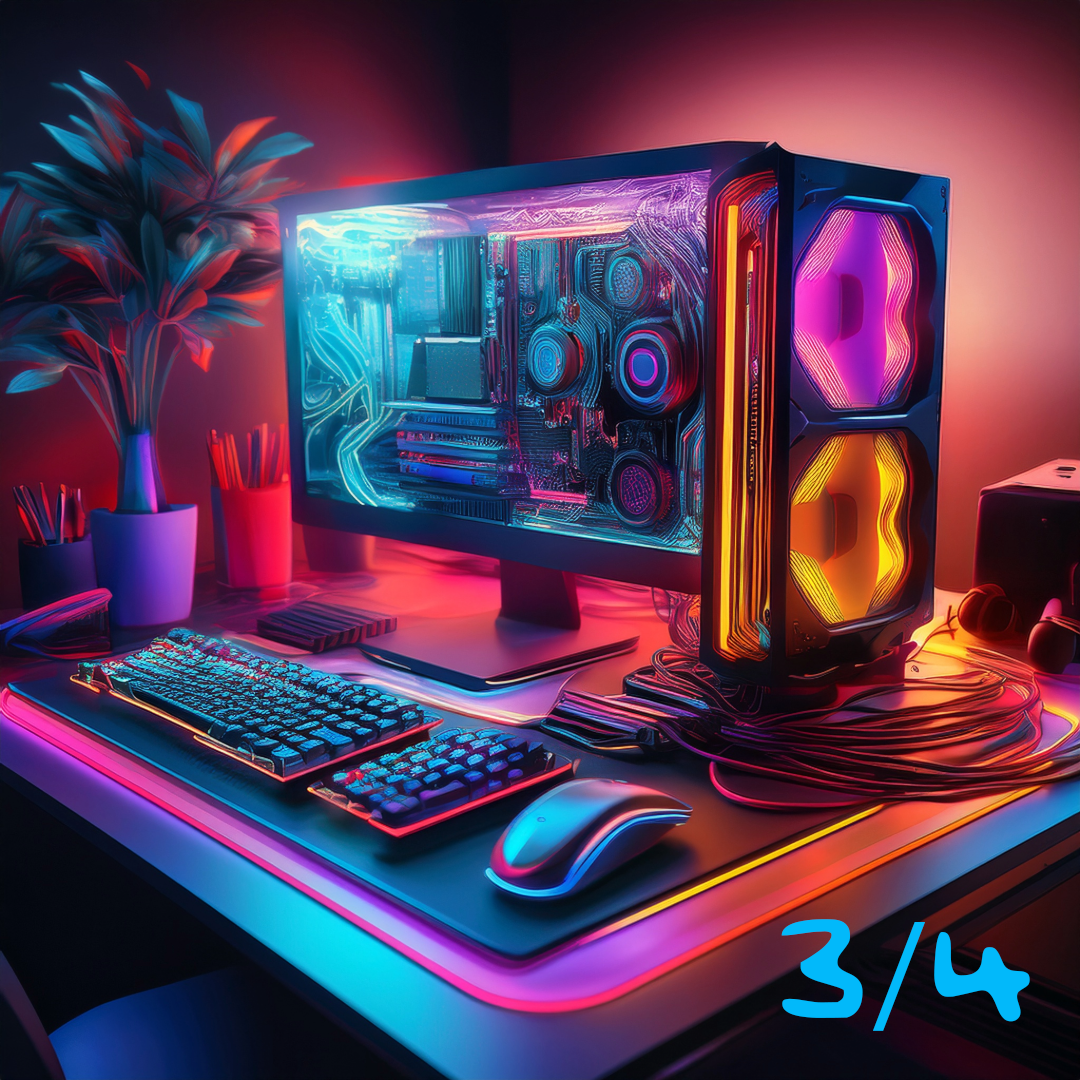The Digital Lifeline: Getting the IT Support You Need for Your Home, Games, and Streams (3/4)
In an increasingly digital world, technology has become an indispensable part of our daily lives. From managing household tasks and staying connected with loved ones to immersive gaming experiences and the dynamic world of online streaming, computers and the internet are central to how we live, work, and play. However, this reliance also means that when things go wrong, the frustration can be significant. Common IT issues can disrupt our routines, halt our progress in games, and even prevent streamers from connecting with their audiences. This guide aims to empower home users, gamers, and streamers by providing practical solutions and guidance to navigate these technological challenges, fostering a greater understanding of common problems and how to resolve them independently. By demystifying these issues, individuals can regain control over their digital experiences and minimize disruptions.
Streaming Seamlessly: IT Support for Streamers
For content creators, a reliable and high-quality stream is paramount to engaging their audience and building their online presence. Streaming involves broadcasting live video and audio, which places significant demands on computer hardware, software, and network infrastructure.
The Show Must Go On: Critical IT Needs for Content Creators
A fundamental requirement for streamers is sufficient Internet Bandwidth, particularly upload speed. Unlike typical home users who primarily download data, streamers need to upload a constant stream of high-quality video and audio . The required upload speed depends on the desired stream resolution and bitrate. For example, streaming at 720p resolution might require a minimum upload speed of 4 Mbps, while 1080p at 60fps could need 10 Mbps or more . Streaming in 4K Ultra HD demands an even higher upload speed, around 25 Mbps . Multiple devices connected to the same network can compete for bandwidth, potentially impacting the stream quality . Therefore, streamers typically need significantly higher upload bandwidth compared to regular home users to ensure a smooth broadcast .
Encoding Issues are another critical aspect of streaming. Encoding is the process of converting raw video and audio into a format suitable for live streaming . This can be done using either hardware or software encoding. Hardware encoding utilizes dedicated components like the GPU to handle this task, often freeing up the CPU for other processes . Software encoding relies on the CPU to perform the encoding, which can be more demanding on system resources . Encoder settings, such as bitrate, resolution, and frame rate, need to be carefully configured based on internet speed and the streaming platform’s recommendations . A high CPU load during software encoding can lead to performance issues and stream instability . Compatibility between the chosen encoding method and the streaming platform is also essential . Selecting the right encoding method and settings is a delicate balance between stream quality and system performance .
Maintaining Audio and Video Synchronization is crucial for a professional and enjoyable viewing experience. Lip-sync issues, where the audio and video are out of sync, can be very distracting for viewers . This problem often arises due to processing delays, where the video and audio streams undergo different levels of compression or are processed at different speeds . Mismatched frame rates between the camera, encoding software, and streaming platform can also cause synchronization problems . Ensuring that audio and video are properly synchronized requires careful configuration and sometimes manual adjustments within the streaming software to add delays to either the audio or video feed .
A streamer’s Hardware and Software Setup is often more complex than that of a typical home user or even a gamer. It can include specialized equipment such as high-quality USB or XLR microphones for clear audio capture . Cameras can range from simple webcams to more advanced DSLRs or mirrorless cameras, often requiring capture cards to input their video feed into the streaming computer, especially for console gaming . Proper lighting, such as ring lights or softboxes, is essential for good video quality . Streaming software like OBS Studio or Streamlabs provides the interface for managing the stream, adding overlays, and interacting with viewers . Many streamers also utilize a dual monitor setup, with one screen for gaming or content creation and the other for managing the stream and chat . The specific combination of hardware and software depends on the streamer’s content, platform, and budget .
Streamers also encounter Platform-Specific Problems related to the streaming service they use, such as Twitch, YouTube, or others. These can include connection issues when trying to go live, various error messages generated by the platform, and the need to correctly manage stream keys, which are unique identifiers for their broadcast . Each platform has its own set of technical requirements, recommended settings, and content guidelines that streamers must adhere to . Troubleshooting often involves understanding the specific error messages and platform settings .
Ensuring good Stream Quality and Buffering for viewers is a constant concern. Buffering occurs when the viewer’s internet connection is not fast enough to receive the stream data, causing interruptions in playback . This can be influenced by the streamer’s bitrate settings; a higher bitrate results in better quality but requires more bandwidth from both the streamer and the viewer . The stability of the streamer’s internet connection is also a critical factor . Adaptive bitrate streaming, where the stream quality automatically adjusts based on the viewer’s internet speed, can help mitigate buffering issues for those with slower connections . Network congestion, either on the streamer’s or the viewer’s end, can also contribute to buffering . Maintaining a smooth, buffer-free stream is essential for retaining viewers .
Keeping Your Stream Alive: Best practices and solutions for a smooth streaming experience.
Streamers should first test their internet upload speed using online speed test tools to ensure it meets the minimum and recommended requirements of their chosen streaming platform and desired stream quality . Configuring encoding software with the appropriate bitrate, resolution, and frame rate based on their internet speed and the platform’s guidelines is crucial . For example, YouTube provides recommendations for various resolutions . To troubleshoot audio/video sync issues, streamers can adjust audio or video delay settings within their streaming software, often found in the advanced audio or video settings . Ensuring that the camera, encoding software, and streaming platform are all set to the same frame rate can also help prevent synchronization problems .
Choosing the right equipment is essential. Investing in a good quality microphone significantly improves the audio experience for viewers . The choice between USB and XLR microphones often depends on the streamer’s budget and desired audio quality . Selecting a camera that provides clear video quality, whether it’s a high-definition webcam or a DSLR, is also important . Proper lighting can dramatically enhance the visual appeal of the stream; simple ring lights or strategically placed lamps can make a big difference .
Managing stream keys and understanding the specific settings and potential error messages of the chosen streaming platform is vital for a successful broadcast . Using a wired Ethernet connection for the streaming computer provides a more stable and reliable internet connection compared to Wi-Fi, minimizing the risk of dropped frames or disconnections . Closing any unnecessary applications running in the background on the streaming computer can free up system resources and improve performance . Monitoring the stream health through the streaming software and paying attention to viewer feedback in the chat can help identify and address any technical issues promptly . Finally, having backup plans in place, such as an alternative internet source (e.g., mobile hotspot) or spare equipment for critical components like the microphone or camera, can help prevent major disruptions during a live stream .
| Resolution | Minimum Recommended Upload Speed (Mbps) |
|---|---|
| 720p | 4 Mbps |
| 1080p | 6 Mbps |
| 1080p 60fps | 10 Mbps |
| 4K Ultra HD | 25 Mbps |












Add comment